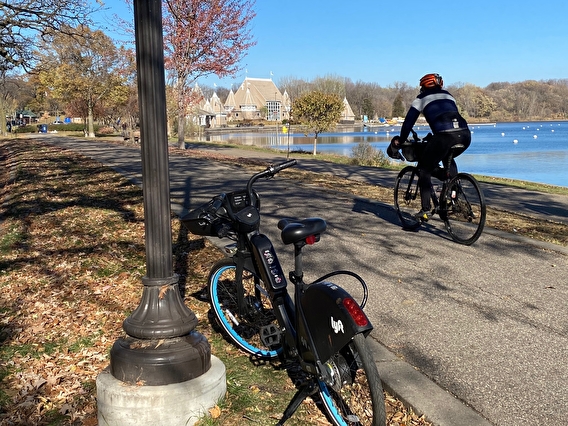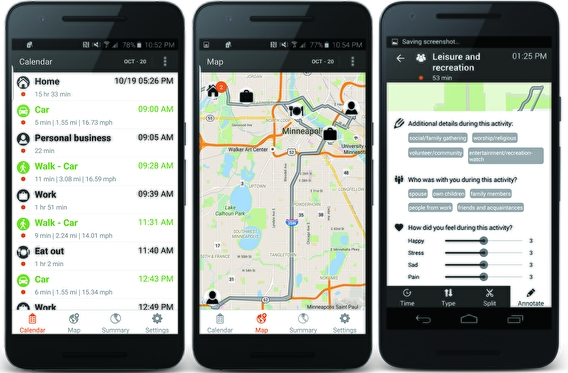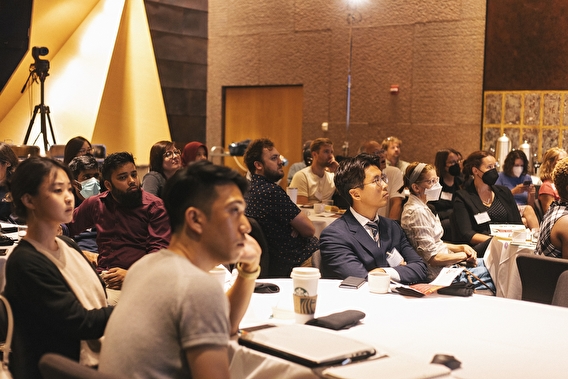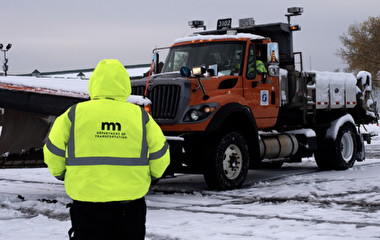
How happy are you on your daily commute? It may seem like a small detail, but when researchers track this type of everyday data on a large scale, it leads to important new discoveries in social and health sciences as well as in transportation. An innovative app is making it easier to collect this valuable data.
At a one-day symposium on July 29, researchers from across the country gathered on the U’s Minneapolis campus to explore the groundbreaking work being done using Daynamica, a digital app developed by an interdisciplinary team of U of M researchers.
“Daynamica is an app we developed and later patented for collecting human activity and well-being data throughout the day,” said Yingling Fan, co-founder and chief scientific officer of Daynamica Inc.
This smartphone-based technology integrates mobile GPS sensing with subjective data entered by users, which allows researchers to accurately capture the ordinary activities and experiences people encounter daily. “Though these details may seem mundane, they can lead to profound insights into everyday life,” said Fan, a professor in the Humphrey School of Public Affairs.
Daynamica was first created 10 years ago, beginning as the SmarTrAC app developed with funding from the U.S. Department of Transportation and CTS. Since then, it has gone through multiple rounds of improvement and refinement, received a U.S. patent, and spurred a wealth of new research—it’s been used for 4 doctoral dissertations, 18 research grants, and more than 30 publications.
At the symposium, speakers discussed the ways Daynamica has transformed their research. For Samantha Gailey, using Daynamica for her greenspace exposure research has led to a more nuanced and dynamic approach to quantifying the health benefits of greenspace.

“Traditionally, greenspace exposure research was done using data at the census-tract level, but that is a very static and home-based measure that doesn’t account for individuals’ movement patterns,” said Gailey, a population health postdoctoral fellow in the U’s Minnesota Population Center. “Daynamica allows me to go from a static to a dynamic measure of greenspace exposure—because it is GPS-based, it captures individuals’ realized exposure to green and blue spaces.”
In Gailey’s latest project, study participants used Daynamica to track their travel and trip happiness levels, and that data was linked with measures of green- and blue-space exposure along travel routes in the Twin Cities area. Findings from the study show that the happier routes are closer to the Mississippi River and area lakes, and that exposure to green and blue spaces on travel routes may be especially beneficial for females.
At Texas A&M University’s Human Bio-Behavioral Signals (HUBBS) Lab, Jinwoo Kim is investigating new approaches for assessing walkability using Daynamica. In his research, Kim integrates Daynamica with bio-signal data collected from smartwatches—in effect, using pedestrians as sensors for environmental distress.
“Conventionally, a checklist or assessment is used to evaluate negative environmental stimuli for pedestrians such as trash, blocked sidewalks, or uneven surfaces,” Kim said. “However, these have inherent limitations, including time, cost, subjectivity, and inability to account for the needs of different users.”
Kim found that the bio-signals collected from pedestrians can be used to identify these negative stimuli. “Eventually, this information could be layered over walking routes in mapping applications to help pedestrians plan the best routes and help communities improve their walking facilities,” he said.

Many researchers are also using Daynamica to study health and its connection to transportation. For example, U of M School of Kinesiology professor Zan Gao looked at the mental health, daily activities, and trip behaviors of breast cancer survivors. His research showed that breast cancer survivors were happier and less tired when they were walking versus taking a car. “A takeaway is that we should encourage breast cancer survivors to incorporate walking as much as possible in their daily life,” Gao said.
Following the research presentations, Daynamica leadership provided updates on the new features and services being developed. These include more flexible user surveys, customizable types of activities and trips, and improvements to make the app easier to use for study participants. Attendees also participated in breakaway sessions to discuss additional services and features they would be interested in seeing in the future.
“We are a business based on universities, by the researchers and for the researchers,” said Daynamica CEO and co-founder Guang Yang. “Our commitment is to support you through every step of your research process and continue to develop new features and services in the future based upon feedback from our users and collaborators.”
If you were not able to attend the symposium or missed a key presentation, you can access symposium video recordings and catch up.
Writer: Megan Tsai


